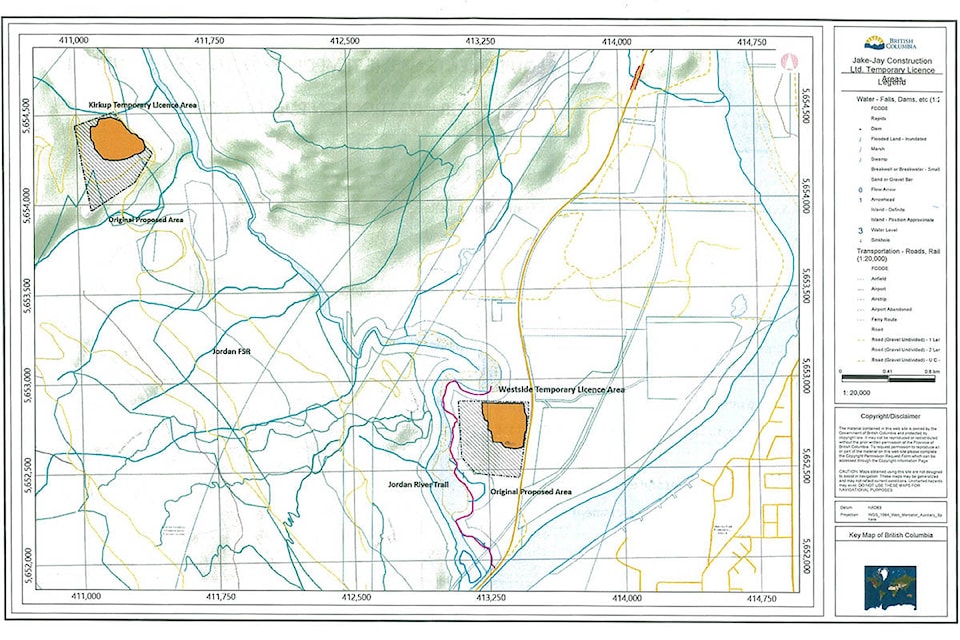Last week Jake-Jay Construction held an information session about the temporary licence to occupy that they have been granted for a section of land near the Jordan River, as well as a second location in the Kirkup region.
More than 50 Revelstoke residents were at the meeting sharing their concerns about the potential development of a gravel pit in the area.
READ MORE: Backlash continues as proposed gravel pit near Revelstoke granted temporary licence
During the meeting there were several questions that Grusky Layco, president of Jake-Jay, was unable to answer. The Revelstoke Review made note of them and asked the Ministry of Forests, Lands, Natural Resource Operations and Rural Development as well as the Ministry of Energy, Mines and Petroleum Resources.
What would need to be found in a biological and ecological assessment for this project not to be approved?
FLNROD spokesperson: “There are various assessments expected as part of the temporary licence. Speculating on the results and the impact of those assessments is not appropriate.”
Do proponents often have to hold public meetings such as this one?
FLNROD spokesperson: “Public meetings such as this are not common. However, they are a good method for the proponent to gather public comments directly related to their project.”
Are there any instances when the public input has caused a permit or license not to be issued?
FLNROD spokesperson: “Yes. All comments submitted into the Applications, Comments and Reasons For Decisions website are considered in the adjudication process. There have been some instances that submitted-comments have led to the need for additional assessments.”
Do operators of gravel pits have to pay per cubic metre of aggregate extracted? Are there exceptions?
FLNROD spokesperson: “Yes, they pay based on the amount of cubic metres extracted. The only exception is for materials such as gravel or aggregate that are used in building public works, such as highways and other local projects.”
How much is it? Where does the money go?
FLNROD spokesperson: “The cost is $2/cubic meter. The royalty is deposited into government’s general revenue account.”
READ MORE: ‘This river is a treasure’-Revelstoke resident opposes gravel pit proposal near Jordan River
What does a reclamation plan require? Does the ministry follow up or visit sites to ensure that the plan is followed?
EMPR spokesperson: “The reclamation plan is a required portion of the mine plan prepared by the applicant and submitted to the Ministry of Energy, Mines and Petroleum Resources in the Notice of Work application.
The reclamation plan objectives are informed by the end land use that is stipulated in the application and conforms to local zoning.
The Mines Act permit may include additional conditions with respect to reclamation prescriptions if necessary to meet objectives or requirements identified by other government agencies or First Nations.
Prior to issuance of a Mines Act permit, the ministry’s inspector of mines assesses a reclamation security based on the full cost of execution of the reclamation plan and prescriptions; the security must be paid by the permittee prior to issuance of the Mines Act permit.
The reclamation security is held by the ministry to ensure that reclamation at the permitted site is completed in accordance with the approved reclamation plan; the chief inspector has the authority to apply the bond towards completion of the reclamation plan should the permittee not complete the plan as required.
Inspectors of mines inspect the mines throughout the life of mine and assess requests to close the mine against the requirements of the permit and the approved mine plan which includes the reclamation plan.”
Is there consequences if a reclamation plan is not completed?
EMPR spokesperson: “If the permittee fails to perform and complete the program for reclamation or comply with the conditions of the permit to the satisfaction of the chief inspector, the chief inspector can apply all or part of the security towards payment of the cost of the work required to be performed or completed.
Furthermore, if the permittee fails to comply orders issued by an inspector, they may be liable to an administrative penalty not exceeding $500,000.00.
If a person fails to pay an administrative penalty, the chief inspector may refuse to consider applications made by that person until the penalties are paid in full.
Money paid to administrative penalties goes into General Revenue. There are further provisions under the Mines Act that involve higher potential fines or imprisonment if convicted of an offence.”
READ MORE: Letter: Proposed gravel pit near Revelstoke is ‘reprehensible’
@JDoll_Revy
jocelyn.doll@revelstokereview.com
Like us on Facebook and follow us on Twitter.
